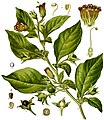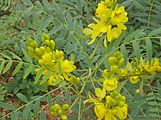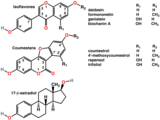| Part of a series on |
| Biochemistry |
|---|
 Chemistry of life Chemistry of life |
| Key components |
| List of biochemists |
| Biomolecule families |
Chemical synthesis
|
| Biochemistry fields |
| Glossaries |
| This article needs more reliable medical references for verification or relies too heavily on primary sources. Please review the contents of the article and add the appropriate references if you can. Unsourced or poorly sourced material may be challenged and removed. Find sources: "Phytochemistry" – news · newspapers · books · scholar · JSTOR (November 2020) |  |
Phytochemistry is the study of phytochemicals, which are chemicals derived from plants. Phytochemists strive to describe the structures of the large number of secondary metabolites found in plants, the functions of these compounds in human and plant biology, and the biosynthesis of these compounds. Plants synthesize phytochemicals for many reasons, including to protect themselves against insect attacks and plant diseases. The compounds found in plants are of many kinds, but most can be grouped into four major biosynthetic classes: alkaloids, phenylpropanoids, polyketides, and terpenoids.
Phytochemistry can be considered a subfield of botany or chemistry. Activities can be led in botanical gardens or in the wild with the aid of ethnobotany. Phytochemical studies directed toward human (i.e. drug discovery) use may fall under the discipline of pharmacognosy, whereas phytochemical studies focused on the ecological functions and evolution of phytochemicals likely fall under the discipline of chemical ecology. Phytochemistry also has relevance to the field of plant physiology.
Techniques
Techniques commonly used in the field of phytochemistry are extraction, isolation, and structural elucidation (MS,1D and 2D NMR) of natural products, as well as various chromatography techniques (MPLC, HPLC, and LC-MS).
Phytochemicals
Many plants produce chemical compounds for defence against herbivores. The major classes of pharmacologically active phytochemicals are described below, with examples of medicinal plants that contain them. Human settlements are often surrounded by weeds containing phytochemicals, such as nettle, dandelion and chickweed.
Many phytochemicals, including curcumin, epigallocatechin gallate, genistein, and resveratrol are pan-assay interference compounds and are not useful in drug discovery.
Alkaloids
Further information: AlkaloidsAlkaloids are bitter-tasting chemicals, widespread in nature, and often toxic. There are several classes with different modes of action as drugs, both recreational and pharmaceutical. Medicines of different classes include atropine, scopolamine, and hyoscyamine (all from nightshade), the traditional medicine berberine (from plants such as Berberis and Mahonia), caffeine (Coffea), cocaine (Coca), ephedrine (Ephedra), morphine (opium poppy), nicotine (tobacco), reserpine (Rauvolfia serpentina), quinidine and quinine (Cinchona), vincamine (Vinca minor), and vincristine (Catharanthus roseus).
-
 The opium poppy Papaver somniferum is the source of the alkaloids morphine and codeine.
The opium poppy Papaver somniferum is the source of the alkaloids morphine and codeine.
-
 The alkaloid nicotine from tobacco binds directly to the body's Nicotinic acetylcholine receptors, accounting for its pharmacological effects.
The alkaloid nicotine from tobacco binds directly to the body's Nicotinic acetylcholine receptors, accounting for its pharmacological effects.
-
 Deadly nightshade, Atropa belladonna, yields tropane alkaloids including atropine, scopolamine and hyoscyamine.
Deadly nightshade, Atropa belladonna, yields tropane alkaloids including atropine, scopolamine and hyoscyamine.
-
 N,N-Dimethyltryptamine (DMT) a powerful psychedelic compound which is present in several plant species found across the globe, commonly found in Mimosa and Acacia species but has also been discovered in grasses such as Philaris Aquatica.
N,N-Dimethyltryptamine (DMT) a powerful psychedelic compound which is present in several plant species found across the globe, commonly found in Mimosa and Acacia species but has also been discovered in grasses such as Philaris Aquatica.
Glycosides
Further information: GlycosidesAnthraquinone glycosides are found in senna, rhubarb, and Aloe.
The cardiac glycosides are phytochemicals from plants including foxglove and lily of the valley. They include digoxin and digitoxin which act as diuretics.
-
 Senna alexandrina, containing anthraquinone glycosides, has been used as a laxative for millennia.
Senna alexandrina, containing anthraquinone glycosides, has been used as a laxative for millennia.
-
 The foxglove, Digitalis purpurea, contains digoxin, a cardiac glycoside. The plant was used to treat heart conditions long before the glycoside was identified.
The foxglove, Digitalis purpurea, contains digoxin, a cardiac glycoside. The plant was used to treat heart conditions long before the glycoside was identified.
-
 Digoxin is used to treat atrial fibrillation, atrial flutter and sometimes heart failure.
Digoxin is used to treat atrial fibrillation, atrial flutter and sometimes heart failure.
Polyphenols
Further information: PolyphenolPolyphenols of several classes are widespread in plants, including anthocyanins, phytoestrogens, and tannins. Polyphenols are secondary metabolites produced by almost every part of plants, including fruits, flowers, leaves and bark.
-
 Angelica, containing phytoestrogens
Angelica, containing phytoestrogens
-
 Polyphenols include phytoestrogens (top and middle)
Polyphenols include phytoestrogens (top and middle)
-
 Anthocyanins are a class of polyphenol that contributes to the color of many plants.
Anthocyanins are a class of polyphenol that contributes to the color of many plants.
-
 Tannic acids are one example of many complex polyphenolic structures produced by plants.
Tannic acids are one example of many complex polyphenolic structures produced by plants.
Terpenes
Further information: TerpenesTerpenes and terpenoids of many kinds are found in resinous plants such as the conifers. They are aromatic and serve to repel herbivores. Their scent makes them useful in essential oils, whether for perfumes such as rose and lavender, or for aromatherapy. Some have had medicinal uses: thymol is an antiseptic and was once used as a vermifuge (anti-worm medicine).
-
 The essential oil of common thyme (Thymus vulgaris), contains the monoterpene thymol, an antiseptic and antifungal.
The essential oil of common thyme (Thymus vulgaris), contains the monoterpene thymol, an antiseptic and antifungal.
-
 Thymol is one of many terpenes found in plants.
Thymol is one of many terpenes found in plants.
-
 Terpenes are polymer of isoprene
Terpenes are polymer of isoprene
Genetics
Contrary to bacteria and fungi, most plant metabolic pathways are not grouped into biosynthetic gene clusters, but instead are scattered as individual genes. Some exceptions have been discovered: steroidal glycoalkaloids in Solanum, polyketides in Pooideae, benzoxazinoids in Zea mays, triterpenes in Avena sativa, Cucurbitaceae, Arabidopsis, and momilactone diterpenes in Oryza sativa.
References
- "Angiosperms: Division Magnoliophyta: General Features". Encyclopædia Britannica (volume 13, 15th edition). 1993. p. 609.
- Meskin, Mark S. (2002). Phytochemicals in Nutrition and Health. CRC Press. p. 123. ISBN 978-1-58716-083-7.
- Springbob, Karen; Kutchan, Toni M. (2009). "Introduction to the different classes of natural products". In Lanzotti, Virginia (ed.). Plant-Derived Natural Products: Synthesis, Function, and Application. Springer. p. 3. ISBN 978-0-387-85497-7.
- Baell, Jonathan; Walters, Michael A. (24 September 2014). "Chemistry: Chemical con artists foil drug discovery". Nature. 513 (7519): 481–483. Bibcode:2014Natur.513..481B. doi:10.1038/513481a. PMID 25254460.
- Dahlin JL, Walters MA (July 2014). "The essential roles of chemistry in high-throughput screening triage". Future Medicinal Chemistry. 6 (11): 1265–90. doi:10.4155/fmc.14.60. PMC 4465542. PMID 25163000.
- ^ "Atropa Belladonna" (PDF). The European Agency for the Evaluation of Medicinal Products. 1998. Archived from the original (PDF) on 17 April 2018. Retrieved 26 February 2017.
- Gremigni, P.; et al. (2003). "The interaction of phosphorus and potassium with seed alkaloid concentrations, yield and mineral content in narrow-leafed lupin (Lupinus angustifolius L.)". Plant and Soil. 253 (2). Heidelberg: Springer: 413–427. Bibcode:2003PlSoi.253..413G. doi:10.1023/A:1024828131581. JSTOR 24121197. S2CID 25434984.
- "Nicotinic acetylcholine receptors: Introduction". IUPHAR Database. International Union of Basic and Clinical Pharmacology. Archived from the original on 29 June 2017. Retrieved 26 February 2017.
- ^ Hietala, P.; Marvola, M.; Parviainen, T.; Lainonen, H. (August 1987). "Laxative potency and acute toxicity of some anthraquinone derivatives, senna extracts and fractions of senna extracts". Pharmacology & Toxicology. 61 (2): 153–6. doi:10.1111/j.1600-0773.1987.tb01794.x. PMID 3671329.
- John T. Arnason; Rachel Mata; John T. Romeo (2013-11-11). Phytochemistry of Medicinal Plants. Springer Science & Business Media. ISBN 9781489917782.
- ^ "Active Plant Ingredients Used for Medicinal Purposes". United States Department of Agriculture. Retrieved 18 February 2017.
- "Digitalis purpurea. Cardiac Glycoside". Texas A&M University. Archived from the original on 2 July 2018. Retrieved 26 February 2017.
The man credited with the introduction of digitalis into the practice of medicine was William Withering.
- ^ "Flavonoids". Micronutrient Information Center, Linus Pauling Institute, Oregon State University. 1 February 2016. Retrieved 11 October 2023.
- Tchen, T. T. (1965). "Reviewed Work: The Biosynthesis of Steroids, Terpenes & Acetogenins". American Scientist. 53 (4). Research Triangle Park, NC: Sigma Xi, The Scientific Research Society: 499A – 500A. JSTOR 27836252.
- Singsaas, Eric L. (2000). "Terpenes and the Thermotolerance of Photosynthesis". New Phytologist. 146 (1). New York: Wiley: 1–2. doi:10.1046/j.1469-8137.2000.00626.x. JSTOR 2588737.
- ^ "Thymol (CID=6989)". NIH. Retrieved 26 February 2017.
THYMOL is a phenol obtained from thyme oil or other volatile oils used as a stabilizer in pharmaceutical preparations, and as an antiseptic (antibacterial or antifungal) agent. It was formerly used as a vermifuge.
- Roy, Kuhu (2015-09-01). "Tinospora cordifolia stem supplementation in diabetic dyslipidemia: an open labelled randomized controlled trial". Functional Foods in Health and Disease. 5 (8): 265–274. doi:10.31989/ffhd.v5i8.208. ISSN 2160-3855.
- Lacchini, Elia; Goossens, Alain (2020-10-06). "Combinatorial Control of Plant Specialized Metabolism: Mechanisms, Functions, and Consequences". Annual Review of Cell and Developmental Biology. 36 (1). Annual Reviews: 291–313. doi:10.1146/annurev-cellbio-011620-031429. ISSN 1081-0706. PMID 32559387. S2CID 219947907.
| Botany | |||||||||||
|---|---|---|---|---|---|---|---|---|---|---|---|
| Subdisciplines | |||||||||||
| Plant groups | |||||||||||
| Plant anatomy |
| ||||||||||
| Plant physiology Materials | |||||||||||
| Plant growth and habit | |||||||||||
| Reproduction | |||||||||||
| Plant taxonomy | |||||||||||
| Practice | |||||||||||
| |||||||||||